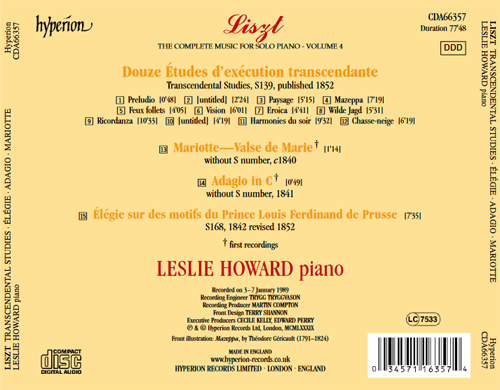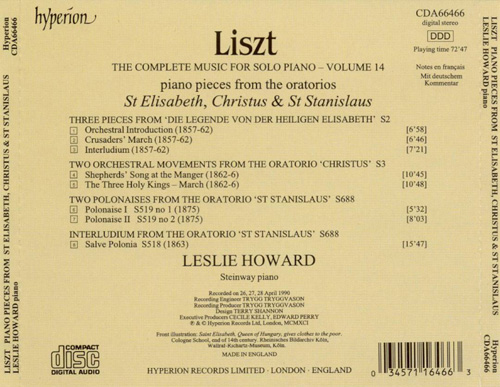 A la Chapelle Sixtine is a very unusual work, inspired by Liszt’s hearing two very different motets in the Sistine Chapel: the famous Miserere mei Deus by Gregorio Allegri (1582–1652), and Mozart’s last work of this kind—the Ave verum corpus, K618, of 1791. The story of Allegri’s work is well-known: composed for the papal choir at the time of Urban VIII, the work was not permitted to be published, and it circulated for centuries in a handful of written copies. The fourteen-year-old Mozart copied the piece from memory. Although the original piece is famous for its antiphonal chorus with high Cs, Liszt concentrates on the marvellous harmonies of its beginning, and uses them to generate a passacaglia in G minor whose variations come to a stormy climax before the Mozart piece is revealed in the simplest transcription in B major. By way of one of Liszt’s finest modulatory passages, the variations return, much shortened, before the Mozart reappears, this time in F sharp—incidentally, it is this passage which Tchaikovsky used as the basis for the slow movement of his fourth orchestral Suite, opus 61, ‘Mozartiana’. Liszt extends Mozart’s music to allow a gentle modulation to G major, and the piece finishes with distant hints of the Allegri in the bass. Liszt made an orchestral version of the piece which has, at the time of writing, never been published or performed, a version for piano duet, and a rather more frequently performed version for organ—with the title improved by the adding of the initial word ‘Évocation’.
A la Chapelle Sixtine is a very unusual work, inspired by Liszt’s hearing two very different motets in the Sistine Chapel: the famous Miserere mei Deus by Gregorio Allegri (1582–1652), and Mozart’s last work of this kind—the Ave verum corpus, K618, of 1791. The story of Allegri’s work is well-known: composed for the papal choir at the time of Urban VIII, the work was not permitted to be published, and it circulated for centuries in a handful of written copies. The fourteen-year-old Mozart copied the piece from memory. Although the original piece is famous for its antiphonal chorus with high Cs, Liszt concentrates on the marvellous harmonies of its beginning, and uses them to generate a passacaglia in G minor whose variations come to a stormy climax before the Mozart piece is revealed in the simplest transcription in B major. By way of one of Liszt’s finest modulatory passages, the variations return, much shortened, before the Mozart reappears, this time in F sharp—incidentally, it is this passage which Tchaikovsky used as the basis for the slow movement of his fourth orchestral Suite, opus 61, ‘Mozartiana’. Liszt extends Mozart’s music to allow a gentle modulation to G major, and the piece finishes with distant hints of the Allegri in the bass. Liszt made an orchestral version of the piece which has, at the time of writing, never been published or performed, a version for piano duet, and a rather more frequently performed version for organ—with the title improved by the adding of the initial word ‘Évocation’.
The passing of the age of deriding the transcription allows us to be joyful at one composer’s enthusiasm and understanding of the works of another. Transcription, in any case, has been a valid way of music making in almost every generation of the history of Western music, and it cannot be simply assumed that the gramophone has replaced it as a likely means of disseminating music not often encountered in live performance. In the case of his very careful arrangements of seven of Bach’s greatest organ works, it should be mentioned that Liszt was at the forefront of the revival of serious study of polyphonic organ playing and the independent study of the pedalboard in order to restore the neglected Bach to his public. Liszt also published an edition of Bach’s organ music in which he also added two other pieces of Bach in his own transcription for the organ. The Sechs Präludien und Fugen für die Orgel-pedal und -manual von Johann Sebastian Bach—Für das Pianoforte zu zwei Händen gesetzt von Franz Liszt were the first in a long series of Bach transcriptions by many of the great pianists and pianist-composers which extended from the mid-nineteenth century to our own times through such names as Brahms, Tausig, Saint-Saëns, d’Albert, Busoni, Reger, Grainger, Rachmaninov and Bartók. Apart from the obvious purpose of communicating Bach’s music through the instrument with which these composers felt most comfortable, there is also a sense of greater satisfaction at being able to exploit the piano for its innate good qualities in a way that simply playing Bach’s harpsichord and clavichord works on the piano seldom produces. Doubling bass notes in octaves, for example, is present in virtually every piano piece in the literature, and the use of the sustaining pedal not just as a colouring device, but also to hold notes which the fingers cannot keep depressed, and the consequent inevitable blurring of some counterpoint, is equally ubiquitous. Now, the organ works of Bach, especially, are familiar to us from acoustical surroundings in which, willy-nilly, something like the effect of a sustaining pedal is achieved, and the power of the pedal organ is usually such as to make the lowest voice of the texture disproportionately strong. In his transcriptions, Liszt carefully doubles the pedal part in octaves wherever practical and appropriate, but otherwise alters Bach’s text almost never, aside from some necessary octave transpositions to allow the hands to reach all the voices, and the fleshing out of a few rhetorical chords. He adds no tempo directions, dynamics or phrasing marks of any sort. As to Bach’s originals, the question of dating their origin is still unsettled, although most of them date from his time in Weimar. Some were revised later in Cöthen, and at least two of them (E minor and B minor) probably date from his time in Leipzig. It doesn’t really matter; all these works are the mature Bach at his best extended style, and the variety of idea and structure remains astounding to us all. In the playing of the transcriptions it seems best to proceed as Liszt probably did, and to study them on the organ in order not to be tempted into spurious pianistic effects—although the problem of memorising them in versions with and without pedalboard becomes acute. It is worth trying to reproduce the effects of eighteenth-century registration, articulation and ornamentation wherever feasible, and, as with all of Liszt’s literal transcriptions, it is important to go to the best available source of the original in order to check the text—Liszt was generally very scrupulous about the matter, so there are only one or two small corrections to make. In the case of J. Seb. Bachs Orgel Fantasie und Fuge in g-moll—Für Pianoforte gesetzt von Franz v. Liszt Liszt approached the work quite differently. He adds a number of dynamic marks, tempo directions, pedal directions and a certain amount of phrasing. This was possibly at the request of its dedicatee, Sigmund Lebert, the famous piano pedagogue, who may have feared that the average piano student would not know how to cope with a score unadorned by such indications. The piece was certainly published in the Lebert and Stark Piano School. In the revised edition (recorded here), at four places in the Fantasia Liszt suggests an alternative extra voice in place of rests, in no way intending to improve upon Bach, but attempting to recreate the grandeur of this most powerful work by reinforcing the texture. Leslie Howard 


.jpg)








































.jpg)






